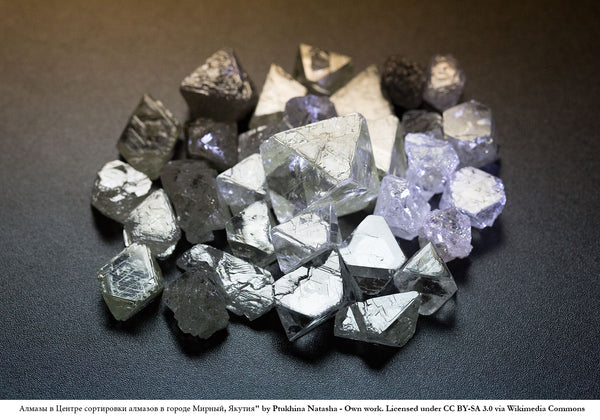If you are about to purchase a diamond for the first time, we understand that it can be a big investment that requires as much information about the product as possible. That is why we have this very useful guide to diamonds.
Diamond is the only gem made of a single element: It is typically about 99.95 percent carbon. The other 0.05 percent can include one or more trace elements, which are atoms that aren’t part of the diamond’s essential chemistry. Some trace elements can influence its colour or crystal shape.
Diamond’s carbon atoms are bonded in essentially the same way in all directions. Another mineral, graphite, also contains only carbon, but its formation process and crystal structure are very different. Graphite is so soft that you can write with it, while diamond is so hard that you can only scratch it with another diamond.
Diamond’s unique optical and physical properties give it the highest possible lustre of any transparent gemstone. This is called adamantine lustre after the Greek word Adamas meaning diamond-like.

Diamonds are formed deep in the earth under extreme heat and pressure. It's transported violently upward until it arrives at or near the earth's surface - where it is discovered by nature or man.
Most modern diamond-mining operations are large in scale and extremely expensive. They consist of giant excavations, hundreds of feet deep, and they require the use of enormous hydraulic shovels and massive earthmovers. Many diamond mines are highly mechanized, with miners using sophisticated remote-controlled robotics - not picks and shovels.

The world's love of diamonds began in India, where diamonds where diamonds were gathered from the country’s rivers and streams. Some historians estimate that India was trading in diamonds as early as the fourth century BC. The country’s resources yielded limited quantities for an equally limited market: India’s very wealthy classes. Gradually, though, this changed. Indian diamonds found their way, along with other exotic merchandise, to Western Europe in the caravans that traveled to Venice’s medieval markets. By the 1400s, diamonds were becoming fashionable accessories for Europe’s elite.
In the early 1700s, as India’s diamond supplies began to decline, Brazil emerged as an important source. Diamonds were discovered in the pans of gold miners as they sifted through the gravels of local rivers. Once it reached its full potential, Brazil dominated the diamond market for more than 150 years.
The story of the modern diamond market really begins on the African continent, with the 1866 discovery of diamonds in Kimberley, South Africa. Entrepreneur Cecil Rhodes established De Beers Consolidated Mines Limited 22 years later, in 1888. By 1900, De Beers, through its mines in South Africa, controlled an estimated 90 percent of the world’s production of rough diamonds.
In the 1870s, annual production of rough diamonds was well under a million carats. By the 1920s, the figure was around three million carats. Fifty years later, annual production approached 50 million carats, and in the 1990s it surpassed 100 million carats per year.
World diamond mining expanded dramatically with the discovery of sources in Australia in 1985 and important new deposits in northern Canada in 2000.
In the past 50 years alone, scientists have learned a lot about how diamonds form and how they’re transported to the earth’s surface. That knowledge has made it easier to predict locations for new diamond discoveries.
One of the first things most people learn about diamonds is that not all diamonds are created equal. In fact, every diamond is unique. Diamonds come in many sizes, shapes, colours, and with various internal characteristics.
All polished diamonds are valuable. That value is based on a combination of factors. Rarity is one of those factors. Diamonds with certain qualities are more rare—and more valuable—than diamonds that lack them.
Jewellry professionals use a systematic way to evaluate and discuss these factors. Otherwise, there would be no way to compare one diamond to another, and there would be no way to evaluate and discuss the qualities of an individual diamond. Diamond professionals use the grading system developed by the Gemmologocal Institute of America (GIA) in the 1950s, which established the use of four important factors to describe and classify diamonds: Colour, Clarity, Cut, and Carat Weight - these are known as the Four C's.
GIA.EDU
Diamond
In-text: (Gia.edu)
Bibliography: Gia.edu,. 'Diamond'. N.p., 2015. Web. 27 Feb. 2015.